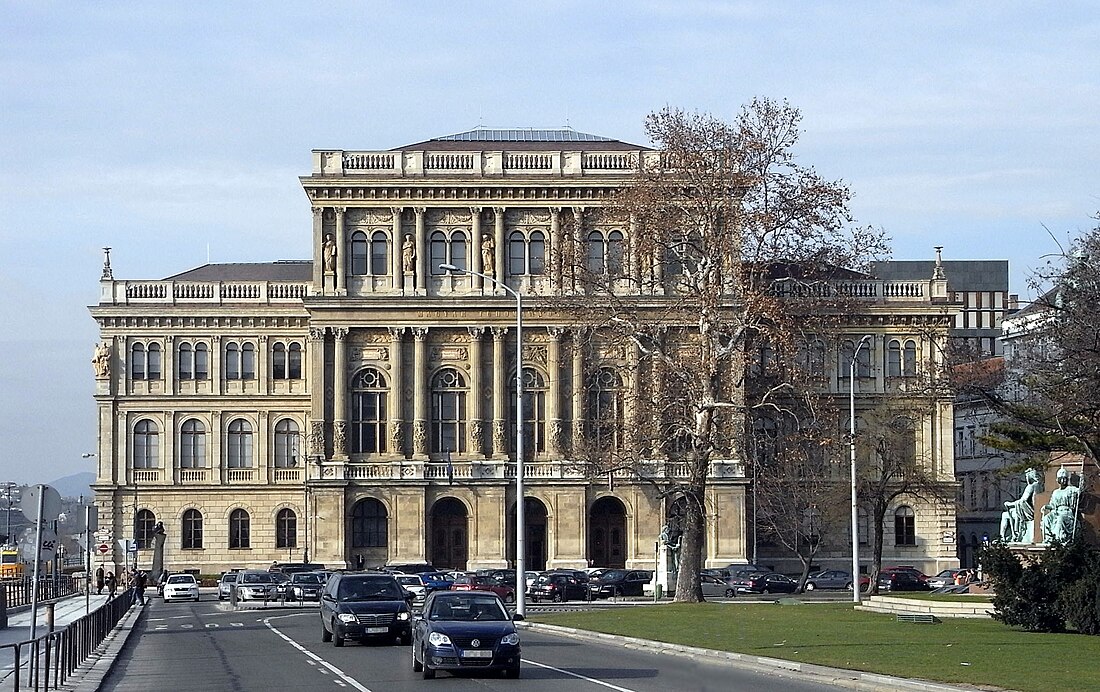Top Qs
Timeline
Chat
Perspective
Hungarian Academy of Sciences
Learned society of Hungary From Wikipedia, the free encyclopedia
Remove ads
The Hungarian Academy of Sciences (Hungarian: Magyar Tudományos Akadémia [ˈmɒɟɒr ˈtudomaːɲoʃ ˈɒkɒdeːmijɒ], MTA) is Hungary’s foremost and most prestigious learned society. Its headquarters are located along the banks of the Danube in Budapest, between Széchenyi rakpart and Akadémia utca. The Academy's primary functions include the advancement of scientific knowledge, the dissemination of research findings, the support of research and development, and the representation of science in Hungary both domestically and around the world.
Remove ads
History
The origins of the Hungarian Academy of Sciences date back to 1825, when Count István Széchenyi offered one year's income from his estate to establish a Learned Society. He made this offer during a session of the Diet in Pressburg (Pozsony, now Bratislava), then the seat of the Hungarian Parliament. Inspired by his gesture, other delegates soon followed suit. The Society’s mission was defined as the development of the Hungarian language and the promotion of sciences and the arts in the Hungarian language. It was officially named the Hungarian Academy of Sciences in 1845. The Academy's central building, designed in the Renaissance Revival architecture by architect Friedrich August Stüler, was inaugurated in 1865.
Remove ads
Sections


Within the Academy, scientific sections are organized according to individual disciplines or closely related fields. Each section monitors, promotes, and evaluates scientific activities within its domain. It provides expert opinions on scientific matters, science policy, and research organization. Additionally, the sections assess the work of the Academy’s research institutes, university departments, and other affiliated research units. They also play a key role in the process of awarding the Doctor of the Hungarian Academy of Sciences (D.Sc.) degree, Hungary’s post-Ph.D. academic qualification.
Today, the Academy is composed of eleven main scientific sections: [3]
- Linguistics and Literary Scholarship
- Philosophy and Historical Sciences
- Mathematics
- Agricultural Sciences
- Medical Sciences
- Engineering Sciences
- Chemical Sciences
- Biological Sciences
- Economics and Law
- Earth Sciences
- Physical Sciences
Remove ads
Research institutes until 2019
- MTA Agricultural Research Centre[4]
- MTA Chemical Research Center
- MTA Research Centre for Astronomy and Earth Sciences (involved with Konkoly Observatory)
- MTA Szeged Research Centre for Biology
- MTA Centre for Ecological Research
- MTA Research Centre for Economic and Regional Studies
- MTA Centre for Energy Research
- MTA Research Centre for the Humanities
- MTA Research Institute for Linguistics
- MTA Rényi Institute of Mathematics
- MTA Institute of Experimental Medicine
- MTA Research Centre for Natural Sciences
- MTA Institute of Nuclear Research
- MTA Wigner Research Centre for Physics
- MTA Centre for Social Sciences
Presidents of the Hungarian Academy of Sciences
Summarize
Perspective
| Count József Teleki | 17 November 1830 – 15 February 1855 |
| Count Emil Dessewffy | 17 April 1855 – 10 January 1866 |
| Baron József Eötvös | 18 March 1866 – 2 February 1871 |
| Baron Menyhért Lónyay | 17 May 1871 – 3 November 1884 |
| Dr. Ágoston Trefort | 28 May 1885 – 22 August 1888 |
| Baron Loránd Eötvös | 3 May 1889 – 5 October 1905 |
| Albert Berzeviczy | 27 November 1905 – 22 March 1936 |
| Archduke Joseph Habsburg | 22 March 1936 – October 1944 |
| Gyula Kornis | 7 March 1945 – 29 October 1945 |
| Gyula Moór | 29 October 1945 – 24 July 1946 |
| Zoltán Kodály | 24 July 1946 – 29 November 1949 |
| István Rusznyák | 29 November 1949 – 5 February 1970 |
| Tibor Erdey-Grúz | 5 February 1970 – 16 August 1976 |
| János Szentágothai | 26 October 1976 – 10 May 1985 |
| Iván T. Berend | 10 May 1985 – 24 May 1990 |
| Domokos Kosáry | 24 May 1990 – 9 May 1996 |
| Ferenc Glatz | 9 May 1996 – 4 May 2002 |
| Szilveszter Vizi | 5 May 2002 – 6 May 2008 |
| József Pálinkás | 6 May 2008 – 5 May 2014 |
| László Lovász | 6 May 2014 – 31 July 2020 |
| Tamás Freund | 1 August 2020 – present |
Széchenyi Academy of Literature and Arts
The Széchenyi Academy of Literature and Arts (Hungarian: Széchenyi Irodalmi és Művészeti Akadémia) was created in 1992 as an academy associated yet independent from the MTA. Some of the known members are György Konrád, Magda Szabó, Péter Nádas writers, Zoltán Kocsis pianist, Miklós Jancsó, István Szabó film directors. The last president was Károly Makk, film director, who succeeded László Dobszay (resigned on 20 April 2011[5]).
Remove ads
See also
References
External links
Wikiwand - on
Seamless Wikipedia browsing. On steroids.
Remove ads


